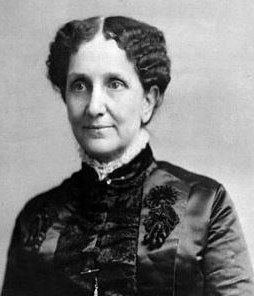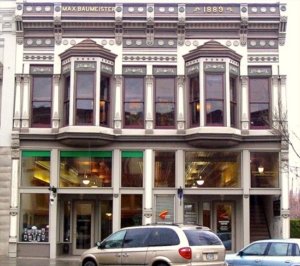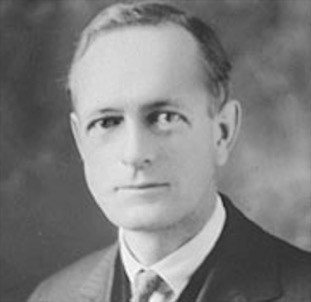A Concise History of Christian Science in Walla Walla, 1895-2018
Stephen Wilen / April 2019
Preface
Mary Baker Eddy (1821-1910), the founder of Christian Science, wrote her groundbreaking book, Science and Health With Key to the Scriptures, in 1875 in which she outlined her fervent conviction that mind (God) nullifies matter (disease). Thus, illness is an illusion rather than a physical manifestation of mortal man, man being immortal. Because it is not a corporeal entity, disease can be expelled by a strong belief in God’s love and power to heal through prayer.
In 1894, Mrs. Eddy and twenty-six of her followers were granted a charter by the Commonwealth of Massachusetts to establish the First Church of Christ, Scientist in Boston – the Mother Church – that opened its doors in 1895. The auditorium could seat 900. A decade later, between 1904 and 1906, a colossal Excelsior Addition was constructed adjoining the original building on the kite-shaped property, with auditorium seating for 3,000.
Within a few years, Christian Science had become the fastest-growing religion in the United States, by 1930 numbering close to 300,000 members, with large and beautiful churches located in all major American cities; even small towns usually boasted at least one Christian Science church. Most Christian Science churches – certainly the larger ones in metropolitan areas – included a reading room. These were generous, comfortable library spaces that included numerous books on Christian Science – many by Mrs. Eddy – and issues for sale of the church’s daily newspaper, the Pulitzer Prize-winning Christian Science Monitor, founded in 1908. Reading rooms maintained regular hours and were staffed by compassionate, caring members of the church who would welcome anyone from a fellow member wanting to do research to a stranger in the depths of misery who simply needed a person with whom he or she could talk. (The First Church of Christ, Scientist in Walla Walla maintained a reading room in its most recent building, but previously the local reading room had occupied spaces over the years in several downtown buildings.) Most cities had at least one Christian Science practitioner whom members could consult for healings. (Reportedly, Walla Walla had four or five practitioners at one point.)
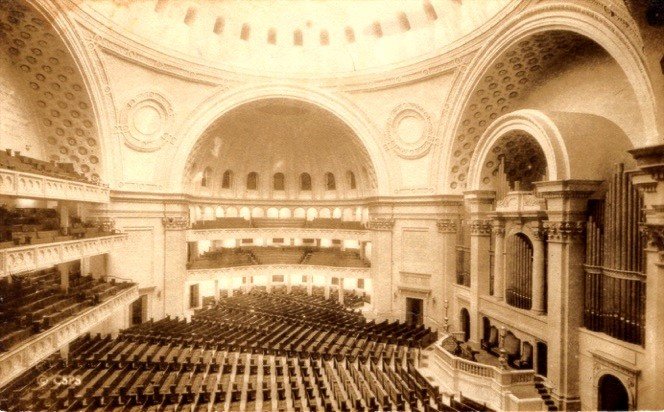
The auditorium of the 1904-06 Excelsior Addition to the Mother Church with seating for 3,000 people. Author photo.
There have been numerous famous people who were raised in and members of the Christian Science church. Among celebrities were Joan Crawford, Doris Day, Mary Pickford, Ginger Rogers, Mickey Rooney and Elizabeth Taylor. In England, American-born Nancy Langhorne (1879-1964) who married Waldorf Astor, becoming Viscountess Astor, and the first woman Member of Parliament, was the most famous Christian Scientist. Two rather less honorable Scientists would have to be H. R. Haldeman, Nixon’s Chief of Staff, and John Erlichman, his Chief Domestic Advisor. (Nixon himself was a Quaker.) Perhaps the most ironic member of the church was Clara Clemens, daughter of Mark Twain, the most dogmatic of Mrs. Eddy’s detractors.
By the mid to latter part of the twentieth century, Christian Science membership had begun to ebb, with many churches closing. In Seattle, over the past two or three decades, the First Church of Christ, Scientist on Capitol Hill was converted to condominiums; the Fourth Church downtown was reconfigured into Town Hall, a venue for musical events, lectures, etc.; and the former Third Church in the University District is now a multi-media venue for pop worship aimed at a younger set. These three venues each had a seating capacity of over 1,000 worshippers. The Christian Science Monitor no longer publishes a daily print edition, in 2009 having morphed primarily to an online presence, though continuing to publish a weekly magazine format print edition. And Walla Walla has no Christian Science practitioners, the nearest one being in Tri-Cities.
Christian Science in Walla Walla began in 1895 as an informal organization with a reading room upstairs in the Baumeister Building at 27½ Main Street (now West Main). From that first gathering, to the opening in 1901 of the First Church of Christ, Scientist of Walla Walla, a branch of the Mother Church, to the permanent closure of the church in 2018, Christian Science maintained a presence in Walla Walla for 123 years. That is worth commemorating and honoring.
It is said that Mrs. Eddy predicted that Christian Science would enter a period of decline from which it would in time be reborn. Will her prophecy prove correct?
The Formative Years of Christian Science in Walla Walla
Around 1884, Mrs. Anna Osgood attended a talk on Christian Science given by Julia Bartlett in McIndoe Falls, Vermont, following which she experienced a healing. She later traveled to Boston to attend classes with Julia Bartlett; that in turn resulted in her enrolling in classes with Mrs. Eddy.
Shortly before Mrs. Osgood’s healing, her sister, Hopie Hunt and her husband Gilbert had moved to Walla Walla. Mrs. Osgood sent two volumes of Science and Health With Key to the Scriptures to her sister in Walla Walla, but Hopie Hunt was not interested, and gave the books to her minister, the Rev. N. F. Cobleigh of First Congregational Church. Rev. Cobleigh had come from Vermont where he had been acquainted with the Hunts, indeed having encouraged their move to Walla Walla. After discussing the contents of Science and Health with Mr. Cobleigh, Mrs. Hunt decided not to read the book and eventually returned both copies to her sister.
In 1886, Gilbert and Hopie Hunt’s son, Eugene, was born, following which her health worsened dramatically. She was diagnosed with tuberculosis, and a uterine fibroid tumor was discovered. At that time such a diagnosis was a death sentence, so Mrs. Hunt took her two children and returned east to arrange for her mother and sister to take care of them following her death.
Mrs. Osgood met them in Boston and wanted to take her sister to see Mrs. Eddy, but Hopie refused to take a meeting with the founder of Christian Science or to discuss anything having to do with Christian Science. When she was ready to return to Walla Walla, her sister, indefatigable, hid another copy of Science and Health in the bottom of Hopie’s trunk.
After returning to Walla Walla, Mrs. Hunt began to experience a healing that defied conventional explanation, arousing some curiosity about Christian Science. Her husband, Gilbert, was also intrigued by her seeming recovery short of any consultation with medical doctors, and together they began to read and study the copy of Science and Health that Hopie’s sister had hidden in the bottom of her trunk. Meanwhile, they kept their membership in First Congregational Church. Nonetheless, as soon as the Hunts got home from Sunday services at First Congregational, Mrs. Hunt would begin reading Science and Health, and it was to Christian Science that the Hunts attributed her remarkable healing.
It is likely that at the time Gilbert and Hopie Hunt were probably the sole students of Christian Science in Walla Walla. However, in 1892 a Mrs. James (Lula) Boucher moved to Walla Walla from Spokane. A Baptist, Mrs. Boucher had also been reading and studying Science and Health, and had experienced a healing. Eventually she and the Hunts met, and together began reading and studying Mrs. Eddy’s book at Mrs. Boucher’s home each Wednesday afternoon.
In July 1894, Hopie’s sister, Anna Osgood, arrived in Walla Walla. Shortly thereafter, she began teaching a class on Christian Science to several persons who had expressed an interest in this “new religion.” An informal organization of interested residents began, soon needing more space than a single home could offer. So in 1895, Walla Walla’s first Christian Science Reading Room was opened upstairs in the Baumeister Building at 27½ Main Street, where services were also held. The reading room closed in July 1895, but services continued to be held in the Hunt and Boucher homes on Sunday mornings and Friday evenings until the reading room was reopened that fall. In May 1896, a Sunday School was established. The Busy Bees, a term coined in 1891 for children active in the church, placed two copies of Science and Health in the State Penitentiary, one copy in the public library and another copy in the Odd Fellows Home. During 1897-1898, the Busy Bees branched out, placing literature in railroad depots and various clubrooms.
In 1898, it was determined that a formal Walla Walla Christian Science Society should be organized, and the following officers were elected: Gilbert A. Hunt, C.S., President; Mrs. Lula Boucher, C.S., Vice President; and Mrs. Anna Osgood, C.S.D., Secretary-Treasurer. (C.S., or Christian Scientist, designated a person who had completed a course in Christian Science, while C.S.D., or Doctor of Christian Science, was conferred only on those who had completed a course of study with Mrs. Eddy.) A Ways and Means Committee included Hopie Hunt, C.S., Mrs. Mary P. Crocker, and Miss Dana Bryant. A constitution and by-laws were drafted, voted on, and accepted, and the Christian Science Society was established October 24, 1898. The Sunday School was formally organized in March 1899 with three teachers.
The reading room continued at 27½ Main Street, and as of April 1899 had established hours of 1 to 5 PM and 7 to 9 PM.
On June 5, 1899, the first Christian Science lecture was held at Small’s Opera House, featuring a disciple of Mrs. Eddy’s, Dr. Francis J. Fluno, M.D., C.S.D. of Boston.
The Ways and Means Committee reported on June 7, 1900 that the Walla Walla Christian Science Society was ready to form a Christian Science church. Following the drafting and adoption of a new constitution and by-laws, the First Church of Christ, Scientist of Walla Walla was incorporated January 7, 1901 under the laws of the State of Washington, as a branch of the Mother Church in Boston. The sixteen charter members were: Mrs. Anna Osgood, C.S.D.; Gilbert Hunt, C.S.; Hopie M. Hunt, C.S.; Mrs. Lula Boucher, C.S.; Mrs. Angelina Hinman, C.S.; Mrs. Mary P. Crocker; Mrs. Mary B. Makay; William H. Wills; George H. Sweeney; Milford H. Broughton; Mrs. Mandana Broughton; Mrs. Viretta Bryant; A. T. Googins; Max Baumeister; and Mrs. Alvina Baumeister.
One week later, fourteen more members were added to the roster: Mrs. Clara G. Wills; Mrs. Louisa Fuller Truax; Chandler N. Bennett, C.S.; Mrs. Henrietta Bennett, C.S.; Mrs. Matilda Schumacher; Mrs. Anna Giles; Mrs. Martha Gaffney Butler; Mrs. Mary E. Northrop; Mrs. Ellen Van; Mrs. Emeline J. Mabry; Mrs. Maude M. Googins; Salem Twist; Mrs. Viola Twist; and Carson O. Carr. A total of thirty members was extraordinary for a new church.
Elected officers on January 7th included: Gilbert Hunt, President; Mrs. Alvina Baumeister, Vice President; Mrs. Lula Boucher, Secretary; and Max Baumeister, Treasurer. Trustees included: Gilbert Hunt, Mrs. Hopie M. Hunt; Mrs. Mary B. Makay; W. H. Wills; Mrs. Mandana Broughton; and Max Baumeister. The first reader was Mrs. Anna Osgood and the second reader was Mrs. Lula Boucher.
As evidenced by some of the above named, several prominent citizens of Walla Walla were early members. Gilbert Hunt was founder and owner of the Gilbert Hunt Company on the north side of Main Street between 7th and 8th Streets, the largest manufacturer of farm and agricultural equipment in the northwest. He was a prominent Mason and a Knight Templar, a member of the [Public] Board of Education, and was a member of the Whitman College Board of Trustees at the time of his death. Max Baumeister, a native of Germany, was a prominent member of the real estate, insurance and loan business for many years. He arrived at Wallula by boat in 1862, reportedly walking the rest of the distance to Walla Walla with but fifteen dollars to his name. From these humble beginnings, he was eventually able to erect two buildings that bore his name, the second of which is extant on West Main Street near 3rd, and a beautiful residence on thirteen acres, extant on Stone Street and Edwards Drive. Viretta Bryant was the widow of John Bryant, and owned extensive acreage along Garrison Creek north of present Bryant Avenue extending roughly between Howard and Division Streets, which was eventually platted and sold as building lots.
Early Locations of First Church of Christ, Scientist of Walla Walla
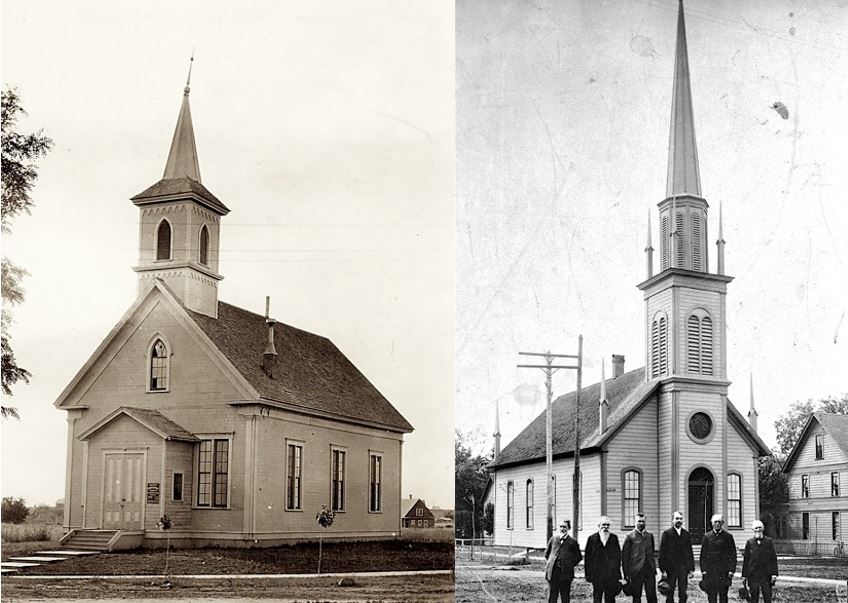
The former First Congregational Church at 2nd and Rose Streets, left, became the first church home for the First Church of Christ, Scientist until 1906, when the congregation rented and later purchased the former Cumberland Presbyterian Church at 3rd and Alder Streets, right.First Congregational Church, UCC photo, left; Whitman Archives photo, right.
In 1900, First Congregational Church vacated its second church building on the southeast corner of 2nd and Rose Streets that had been built in 1868, moving to their brand new building on the northeast corner of South Palouse and Alder Streets (destroyed by fire January 1922). The Congregationalists attempted to sell the vacated property to the local Elks Lodge 287, whose members were considering erecting a new Temple, but that did not materialize, nor did an overture to the Lutherans to rent the empty church building. Eventually, it was rented to the First Church of Christ, Scientist. Gilbert and Hopie Hunt, by now having withdrawn their membership in First Congregational, would have felt right at home in the same building where they had attended Congregational services for years. Sunday services were at 11 AM with Wednesday testimonial meetings at 7:30 PM. The reading room was open daily between 2 and 5 PM.
It is interesting to note that the city directory for 1902 did not list the Christian Science Church under Churches, instead placing the listing under Miscellaneous Societies.
However, in 1906, the Congregational Church sold their 2nd and Rose property and the former church building was moved to the northwest corner of Isaacs and Division Streets where it became Olivet Congregational Church until razed a decade later. The First Church of Christ, Scientist would need to find a new place of worship.
Cumberland Presbyterian Church had been designed and constructed on the southwest corner of 3rd and Alder Streets in 1876 by the early Walla Walla architect and carpenter Norman Butler, a member of that church.
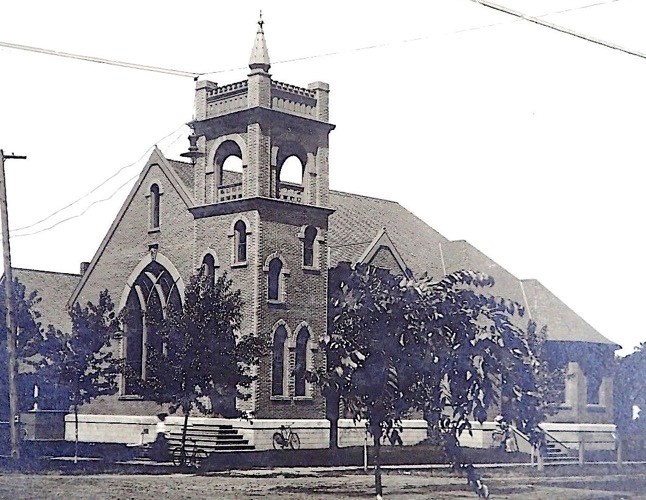
The former Wilbur Memorial Methodist Church building was home to the First Church of Christ, Scientist of Walla Walla from March 1922 through August 1947. Author photo.
By 1906, Cumberland Church had closed and was available for rent. Slightly larger than the former First Congregational Church building, it offered increased seating. After several months, the building was purchased by the Christian Scientists, becoming the first building they owned outright. It was dedicated on Sunday, October 13, 1907, for which invitations had been printed. Gilbert Hunt delivered the welcoming address and Anna Osgood gave the dedication address. By 1912 attendance had grown to the point that evening services were begun.
In 1921, this building was sold, and during the following year Christian Science services reportedly were held in the Moose Hall (this information could not be substantiated).
On January 23, 1922, the First Free Methodist Church transferred by Deed and one dollar the former Wilbur Memorial Methodist Church, constructed in 1903 on the northwest corner of Howard and Newell Streets (extant), to the First Church of Christ, Scientist of Walla Walla. The first services were held in that building March 12, 1922, although the church was not dedicated until the Sunday service June 8, 1930.
A New Building Designed and Built for the First Church of Christ, Scientist
During 1946, the subject of whether to construct a new church building planned specifically for and dedicated to Christian Science or to remodel the current building at Howard and Newell was broached, and members were asked to consider these two alternatives. Meanwhile, there still being $800 owed the Mother Church on a loan from 1923 to purchase the Wilbur Memorial Church building, it was voted to make that final payment on January 7, 1947.
A Building Committee was formed to discuss and attempt to determine the best course of action. A Christian Scientist from Seattle referred the committee to the Seattle architectural firm of George Wellington Stoddard. Stoddard had designed a number of prominent structures in Seattle, and he suggested a former member of his firm, Archibald N. Torbitt (1883-1958), a Christian Scientist who, prior to joining Stoddard’s firm, had designed the First Church of Christ, Scientist in Anacortes (1929) and the First Church of Christ, Scientist in The Dalles, Oregon (1933), both extant. (The former was sold ca. 2010 following closure of the Anacortes Christian Science Church and now serves as a Seventh Day Adventist church; the latter is still functioning as a Christian Science church.)
Torbitt was invited to speak to the Walla Walla congregation, and he gave a presentation on the evening of March 21, 1947. Having examined the current facility carefully, he recommended that because an upgrade to the aging building would cost at least as much as constructing new he would recommend the latter alternative if the existing building could be sold.
Thus, the former Wilbur Memorial Methodist Church building was listed for sale, and eventually an offer of $20,000 cash plus a vacant lot on the southeast corner of 1st and Whitman Streets, valued at $4,000, was made by the Church of Jesus Christ of Latter-Day Saints (Mormons). This offer was accepted June 25, 1947 and by Warranty Deed on August 18, 1947 the transfer was made for the consideration of ten dollars. That meant a move to temporary quarters would have to be made pending completion of the new church. Graciously, Whitman College offered the use of their chapel, located on the third floor of the Whitman Memorial Building, to the Christian Science church for both Sunday services and Wednesday evening testimonial meetings. Arch Torbitt was formally accepted as architect for the new building October 13, 1947.
Some unexplained dissatisfaction arose with Torbitt, though it clearly concerned his fee. Several local architects and one Portland firm were contacted, but when it was seen that their fees were in line with Torbitt’s the church members voted to sign a contract with Torbitt. Preliminary sketches were provided to the Board of Directors and the Architect

The former First Church of Christ, Scientist in Anacortes, left, foreshadowed the church Torbitt designed for Walla Walla nearly two decades later. The Mediterranean-style First Church of Christ, Scientist that Torbitt designed in 1933 for The Dalles, Oregon, right, continues to serve the function for which it was built. Anacortes Museum & Maritime Center photo, left; author photo, right.
Contact Committee March 17, 1948. A formal proposal was presented April 21, 1948, with an estimated $60,000 cost of construction.
Bids for construction were opened September 18, 1948. Two bids were received: O. D. Keen submitted the high bid of $115,000; while A. Ritchie & Co. came in at $103,000. As both were considerably more than had been budgeted, Torbitt suggested that Ritchie’s bid be accepted with the idea that the church would work with him until a more reasonable amount could be agreed upon.
An alternate design plan utilizing less expensive materials was presented, but rejected by the membership. Finally, the church was approved for a loan of an additional $15,000 in the fall of 1949, and a contract was signed with Ritchie in December for $48,968; however, this covered only phase one of the building, to include just the foyer, east wing, Sunday School room, and basement.
Construction was completed in 1950. Initially it was the east wing that was used for Sunday School, with the west wing serving as a temporary auditorium. This arrangement served until 1956 when Torbitt was again involved to fine-tune plans for the balance of the structure, construction of which began in the spring of 1957. The completed church included a new auditorium with balcony, rooms for the two readers and the organist, plus conversion of the two wings to the use for which they had been intended. Seating capacity in the auditorium was 300. A pipe organ was commissioned from the former Seattle firm Balcom & Vaughan, the organ console to be located in a pit directly in front of the readers’ desk so that the organist would not be seen during services. Seating consisted of upholstered theater-type chairs with fold-up seats.
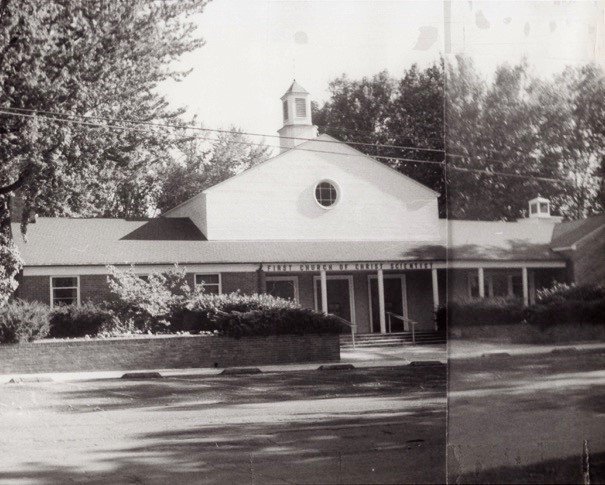
The completed First Church of Christ, Scientist at 1st and Whitman Streets. This undated photo, that appears to be two photos attached, is the only one that could be located of that building. Note the belfry, identical to the one that surmounts the former Christian Science Church in Anacortes. First Church of Christ, Scientist photo.
The exterior of the church is what has been described as modified Georgian Colonial, what might be called today Hollywood Colonial – red brick with white trim. The main flow of the building was longitudinal, north-south, with a gable roof, surmounted by a massive projecting center wood dormer at 180 degrees, painted white and capped with a small rectangular peaked belfry. Neon-illuminated letters that spelled out First Church of Christ, Scientist were located on the fascia above the tripartite entrance.
The years in this building marked the salad days of Christian Science in Walla Walla in terms of growth and diversity of members’ ages. This period came to an untimely end during a cold winter night in 1985 when the church building, not yet thirty years old, caught fire and was largely destroyed. To prevent ice damage to the structure, an electric heating apparatus had been installed around the eaves that shorted, causing the fire. Another move to temporary quarters had to be made, this time a generous offer being received from Congregation Beth Israel at Alder and Roosevelt Streets. A site for a new church, to be considerably smaller than the church at 1st and Whitman, was purchased on Howard Street. The readers’ desk and sixty of the auditorium seats were saved and placed in the new building that was completed in 1989.
As is the case with many mainstream Protestant churches, as their congregations age, for a multiplicity of reasons they are largely unable to attract new and younger members. This seems to have hit Christian Science churches with dire consequence, as noted in the preface, and in particular the First Church of Christ, Science in Walla Walla. It is to their credit that the Walla Walla church congregation persevered as long as they were able to, in light of the fairly small population of Walla Walla from which to draw and the numerous earlier closures of Christian Science churches in larger cities.
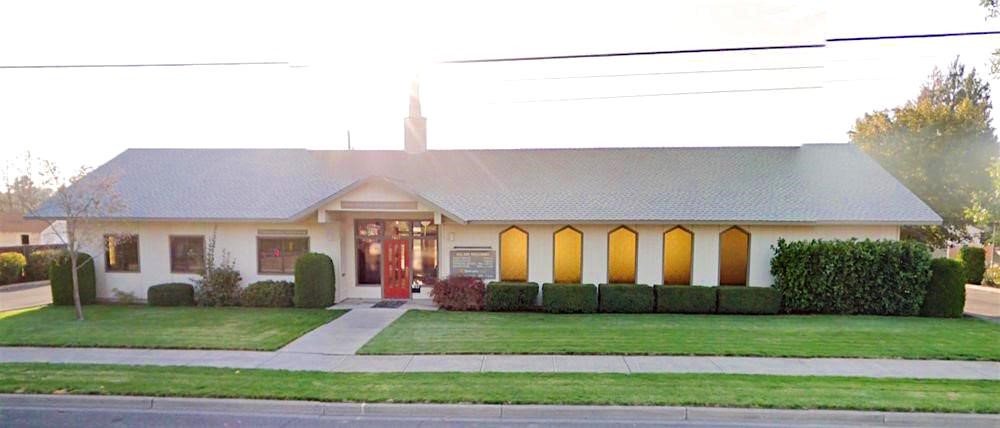
The final building for First Church of Christ, Scientist at 1622 Howard Street. Union-Bulletin photo.
Eventually, however, following a relinquishing of their status as a branch of the Mother Church, the building was listed for sale. An offer was accepted in the fall of 2018, and the final service was observed in November. In consequence, after an existence in Walla Walla for 123 years, Christian Science no longer maintains a physical presence in the Walla Walla valley, the nearest Christian Science Church being in Pasco.
References
- Whitman Archives
- City Directories, various years
- Progress of Christian Science: Walla Walla, Washington in The Christian Science Journal, Vol. 31, no. 1, April 1913, Boston
- Nartonis, David K., Christian Science and Matter in The Christian Science Sentinel, February 22, 1982, Boston
- Lyman, Prof. W. D., Lyman’s History of Old Walla Walla County, Vols. 1 and 2, S. J. Clarke Publishing Company, Chicago, 1918
- Ochsner, Jeffrey Karl, editor, Shaping Seattle Architecture: a Historical Guide to the Architects, University of Washington Press, 1994
- Houser, Michael, Architect Biographies: Archibald N. Torbitt, Washington State Department of Archaeology and Historic Preservation
- Reed, Diana, The Man Who Helped Build Walla Walla; the Local Legacy of Norman Francis Butler, Walla Walla Union-Bulletin, April 16, 2016
- Meeker, Mary, Wilbur Memorial Methodist Church, Walla Walla 2020 Research Report, December 1, 2005
Author’s Note
The author served as organist at the First Church of Christ, Scientist for the Wednesday testimonial meetings, and substituted as needed on Sunday mornings between 2009 and the final service in November 2018. During those years, several members of the church were helpful in providing historical information. These include Neita Stearns of College Place, who grew up in the church, and Sandra Adams of Walla Walla, both of whom were active until the church closed. Additionally, the following members, now deceased, were a source of information over the years: Michal Jacobson and Betty Swenson of Walla Walla; and Elaine Green of Milton-Freewater, OR. Finally, two typed histories of the church that had gone missing until located as the building contents were being packed up in late 2018, were valuable sources of early information. These include History of First Church of Christ, Scientist, Walla Walla, by Mrs. Elsa Emigh, Clerk, dated November 1, 1954; and an untitled continuation of that history through the completion of the church at 1st and Whitman Streets, unsigned other than “Ch. Bldg. Com.” and dated March 20, 1958.

